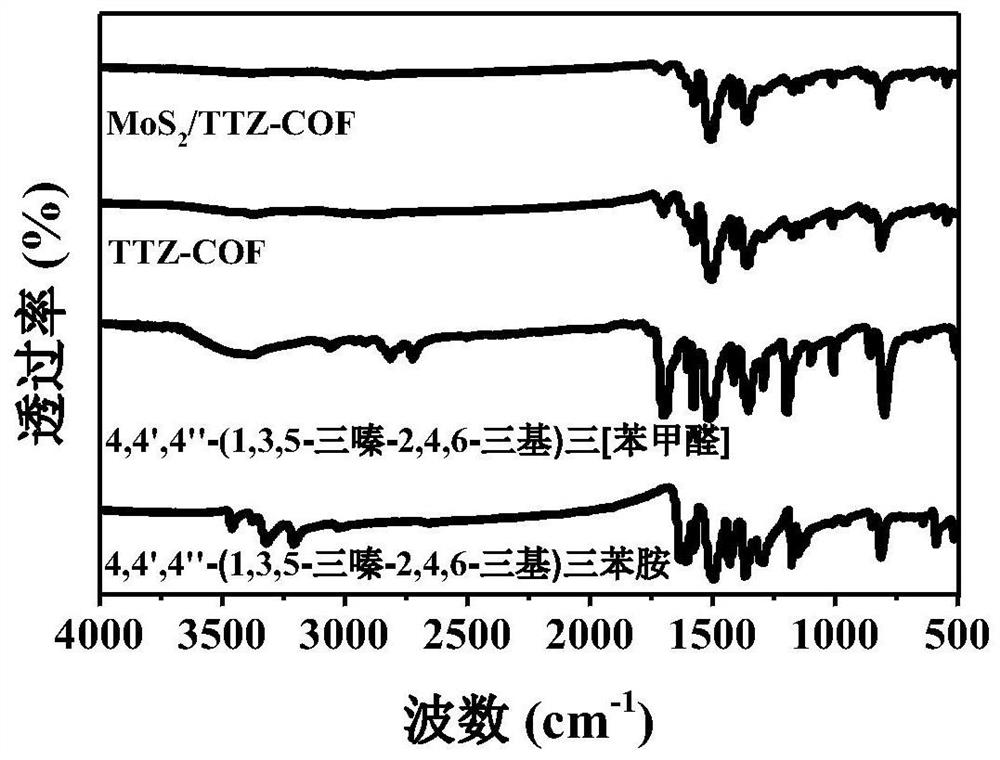Photoanode material based on covalent organic framework as well as preparation method and application of photoanode material
A covalent organic framework, photoanode technology, applied in chemical instruments and methods, organic compound/hydride/coordination complex catalysts, electrodes, etc., can solve the problem of low efficiency
- Summary
- Abstract
- Description
- Claims
- Application Information
AI Technical Summary
Problems solved by technology
Method used
Image
Examples
Embodiment 1
[0034] A photoanode material based on a covalent organic framework, including a cocatalyst and a covalent organic framework based on a triazine structure; wherein, the cocatalyst and the covalent organic framework based on a triazine structure form a two-dimensional layered structure through layer-by-layer stacking .
[0035] Covalent organic framework materials based on the triazine structure have high crystallinity, high specific surface area and good chemical stability, and due to the rich content of N components, they have strong visible light absorption properties and can be used as excellent heterogeneous photocatalysts. , this example proposes a two-dimensional layered structure composed of a cocatalyst and a covalent organic framework TTZ-COF through layer-by-layer stacking, as a photoanode material, the structure is as follows figure 1 As shown, each ring represents one of the above structural units. Among them, the covalent organic framework in the photoanode materi...
Embodiment 2
[0041] A method for preparing a photoanode material based on a covalent organic framework as described in Example 1, comprising: cocatalyst, 4,4',4"-(1,3,5-triazine-2,4, 6-triyl)triphenylamine and 4,4',4"-(1,3,5-triazine-2,4,6-triyl)tri[benzaldehyde] into the 1,4-dioxahexa ring, mesitylene and acetic acid aqueous solution, and react at 100-130° C. for 3-5 days to prepare the photoanode material based on the covalent organic framework.
[0042]By introducing a co-catalyst, the co-catalyst / TTZ-COF co-catalyzed composite system synthesized by in situ reaction under solvothermal conditions can further enhance the light absorption of the composite photoanode material, improve the separation efficiency of photogenerated electrons and hole pairs, Accelerate the transfer of interfacial charges and show good photocatalytic water splitting activity, which makes the covalent organic framework material based on the triazine structure have good application potential in the field of photoca...
Embodiment 3
[0055] An application of a covalent organic framework-based photoanode material as described in Example 1 above for photoelectrochemical decomposition. Specifically, the application can be to cover the photoanode material based on the covalent organic framework described in Example 1 on the FTO substrate as an anode for photoelectrochemical water splitting.
PUM
 Login to View More
Login to View More Abstract
Description
Claims
Application Information
 Login to View More
Login to View More - R&D
- Intellectual Property
- Life Sciences
- Materials
- Tech Scout
- Unparalleled Data Quality
- Higher Quality Content
- 60% Fewer Hallucinations
Browse by: Latest US Patents, China's latest patents, Technical Efficacy Thesaurus, Application Domain, Technology Topic, Popular Technical Reports.
© 2025 PatSnap. All rights reserved.Legal|Privacy policy|Modern Slavery Act Transparency Statement|Sitemap|About US| Contact US: help@patsnap.com



